
Date: July 20, 2021
Location: Lat: 36.930406°, Lon: -58.858593°
Dive depth range: 3,336 - 3,447 meters (10,945 - 11,309 feet)
Access Dive Summary and ROV Data
Given the depth of Dive 15 of the 2012 North Atlantic Stepping Stones expedition, down to 3,400 meters (11,155 feet), scientists didn’t expect to find much life... they were pleasantly surprised by the bountiful life that Allegheny Seamount revealed. Video courtesy of NOAA Ocean Exploration, 2021 North Atlantic Stepping Stones: New England and Corner Rise Seamounts. Download largest version (mp4, 78.5 MB).
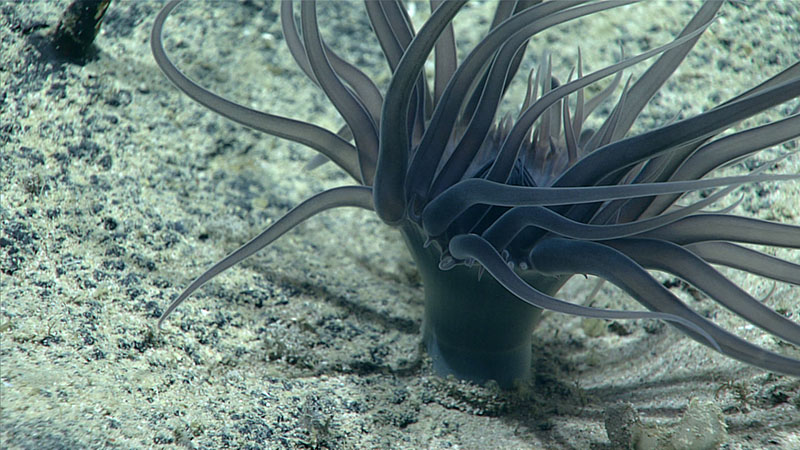
A few cerianthid anemones were seen on Dive 15 of the 2021 North Atlantic Stepping Stones expedition. They are recognizable by possessing both an inner and outer ring of tentacles. A number of anemones can actually eject and lose their tentacles, useful for distracting potential predators while they make their escape. These tentacles can grow back, as shown by the smaller ring of tentacles in the center of this anemone. This particular cerianthid was seen at 3,440 meters (11,286 feet) depth and likely represents an unknown species! Image courtesy of NOAA Ocean Exploration, 2021 North Atlantic Stepping Stones: New England and Corner Rise Seamounts. Download largest version (jpg, 1.2 MB).
During Dive 15 of the 2021 North Atlantic Stepping Stones expedition, we dove to around 3,400 meters (11,155 feet) depth to explore Allegheny Seamount. The geology and substrate morphology encountered on this dive was some of the most varied seen during this expedition so far. The geology was diagnostic of the construction and destruction processes that have acted on the seamount. Biological observations were much more diverse than expected, given the depth of this dive.
We began the dive on a rock debris apron with a mix of sediment and blocks of volcanic material. Two geologic samples were collected at the landing site, both fully encrusted with ferromanganese. As the dive progressed, the remotely operated vehicle crossed over mixed pavement, rock debris, sediment, and tabular failure substrate on an overall moderate-gradient sloped bottom. We saw impressive stacked sheet lava flow layers and abundant evidence of downslope transport of large rocks and tabular blocks, which provided the background for the dive.
The sponge population was particularly diverse during this dive, as we encountered coral morphology sponges (Stelodoryx sp.), Hylanomema spp., encrusting and barrel sponges, as well as an unusual, cream-colored sponge thought to be a glass sponge.
Corals were also very well represented on this dive, particularly by Anthomastus sp. and bamboo corals, as well as Bathygorgia whip corals, Stauropathes black corals, small primnoids, and octocorals. Within the deep cracks of the final sloped overhang area of our dive, we observed a potentially new and unusual morphotype of a Chrysogorgia coral.
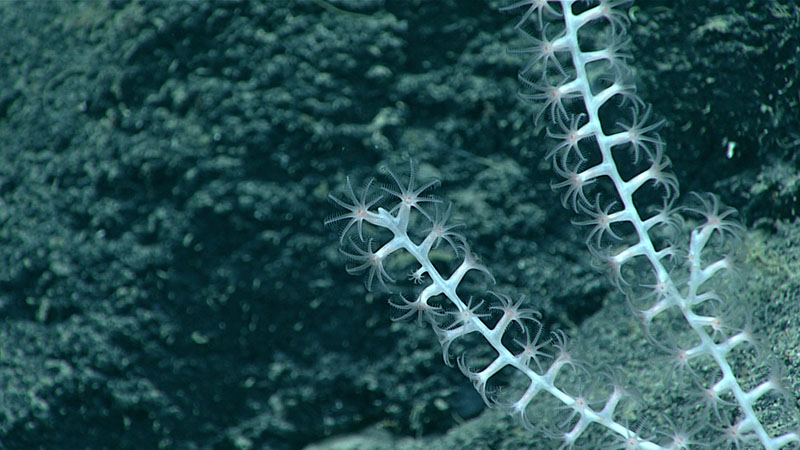
We observed several bamboo corals during Dive 15 of the 2021 North Atlantic Stepping Stones expedition. These corals have an opaque and milky appearance from a distance, due to very small calcareous sclerites (hardened parts of the coral body) that reflect light. Image courtesy of NOAA Ocean Exploration, 2021 North Atlantic Stepping Stones: New England and Corner Rise Seamounts. Download largest version (jpg, 1 MB).
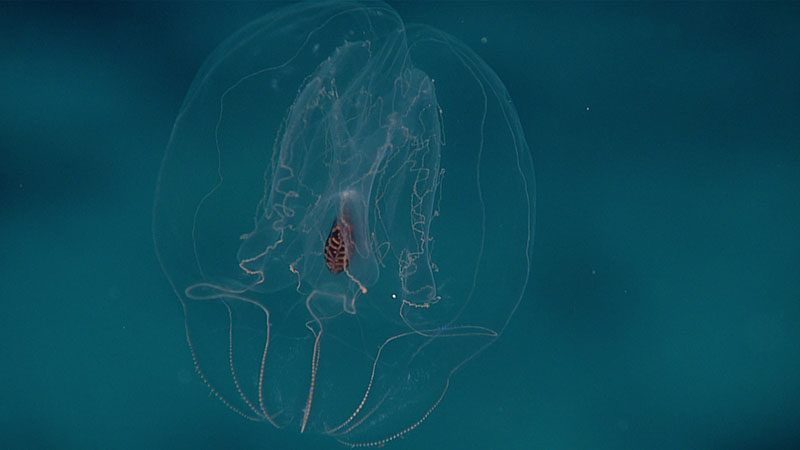
This beautiful ctenophore was observed during Dive 15 of the 2021 North Atlantic Stepping Stones expedition. Ctenophores are predators in the water column, and they swim and hunt for prey. This particular ctenophore has a red stomach, which is useful for hiding any prey they’ve eaten. Because they are completely transparent, any visible prey inside their stomachs may attract larger predators. The color red is also very difficult to see in the deep ocean, helping the ctenophore be as stealthy as possible. Image courtesy of NOAA Ocean Exploration, 2021 North Atlantic Stepping Stones: New England and Corner Rise Seamounts. Download largest version (jpg, 663 KB).
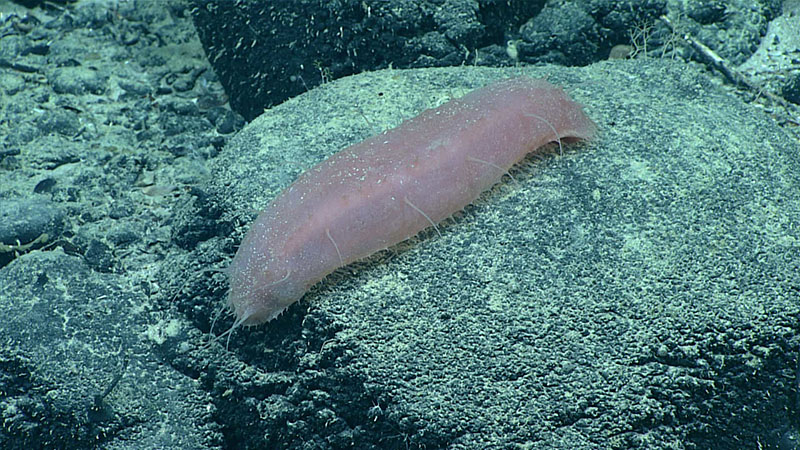
This sea cucumber was observed at 3,385 meters (11,106 feet) depth during Dive 15 of the 2021 North Atlantic Stepping Stones expedition. The digestive tract of this particular sea cucumber is visible through its translucent pink body. Sea cucumbers use their tube feet to wander around the seafloor and eat sediment. They are able to derive nutrients attached to sediments, and the undigested sediment is expelled from their digestive tract; living up to the name that these sea cucumbers are sometimes called the vacuum cleaners of the sea. Image courtesy of NOAA Ocean Exploration, 2021 North Atlantic Stepping Stones: New England and Corner Rise Seamounts. Download largest version (jpg, 1.7 MB).
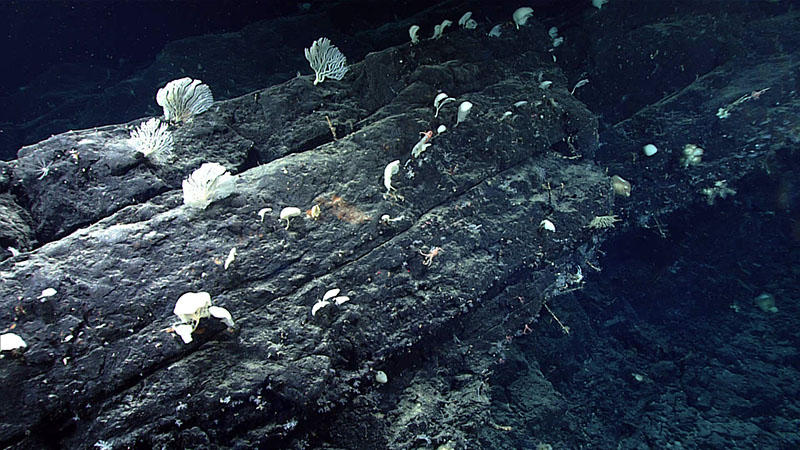
We came across these dipping sheet flow layers rich with biodiversity towards the end of Dive 15 of the 2021 North Atlantic Stepping Stones expedition. These features hosted multiple Stelodoryx sp. and other sponges. On the bottom side of the overhang, we discovered brisingid (Freyella sp.) sea stars, an unusual form of Chrysogorgia coral, stoloniferous octocoral, and an unusual yellow sponge that formed colonies. Image courtesy of NOAA Ocean Exploration, 2021 North Atlantic Stepping Stones: New England and Corner Rise Seamounts. Download largest version (jpg, 1.4 MB).
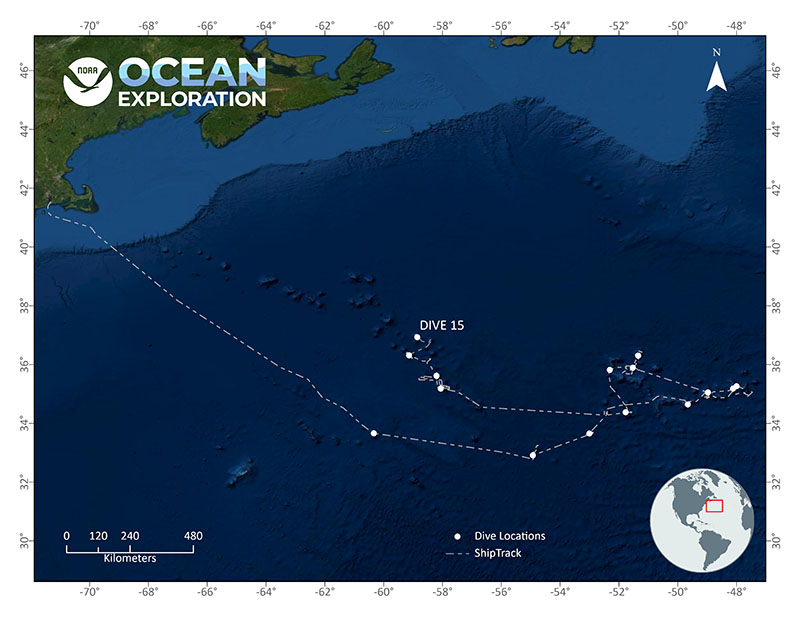
Location of Dive 15 of the 2021 North Atlantic Stepping Stones expedition on July 20, 2021. Map courtesy of NOAA Ocean Exploration, 2021 North Atlantic Stepping Stones: New England and Corner Rise Seamounts. Download largest version (jpg, 3 MB).

Image showing the dive track of Dive 15 of the 2021 North Atlantic Stepping Stones expedition. Scale is water depth in meters. Image courtesy of NOAA Ocean Exploration, 2021 North Atlantic Stepping Stones: New England and Corner Rise Seamounts. Download largest version (jpg, 1.4 MB).